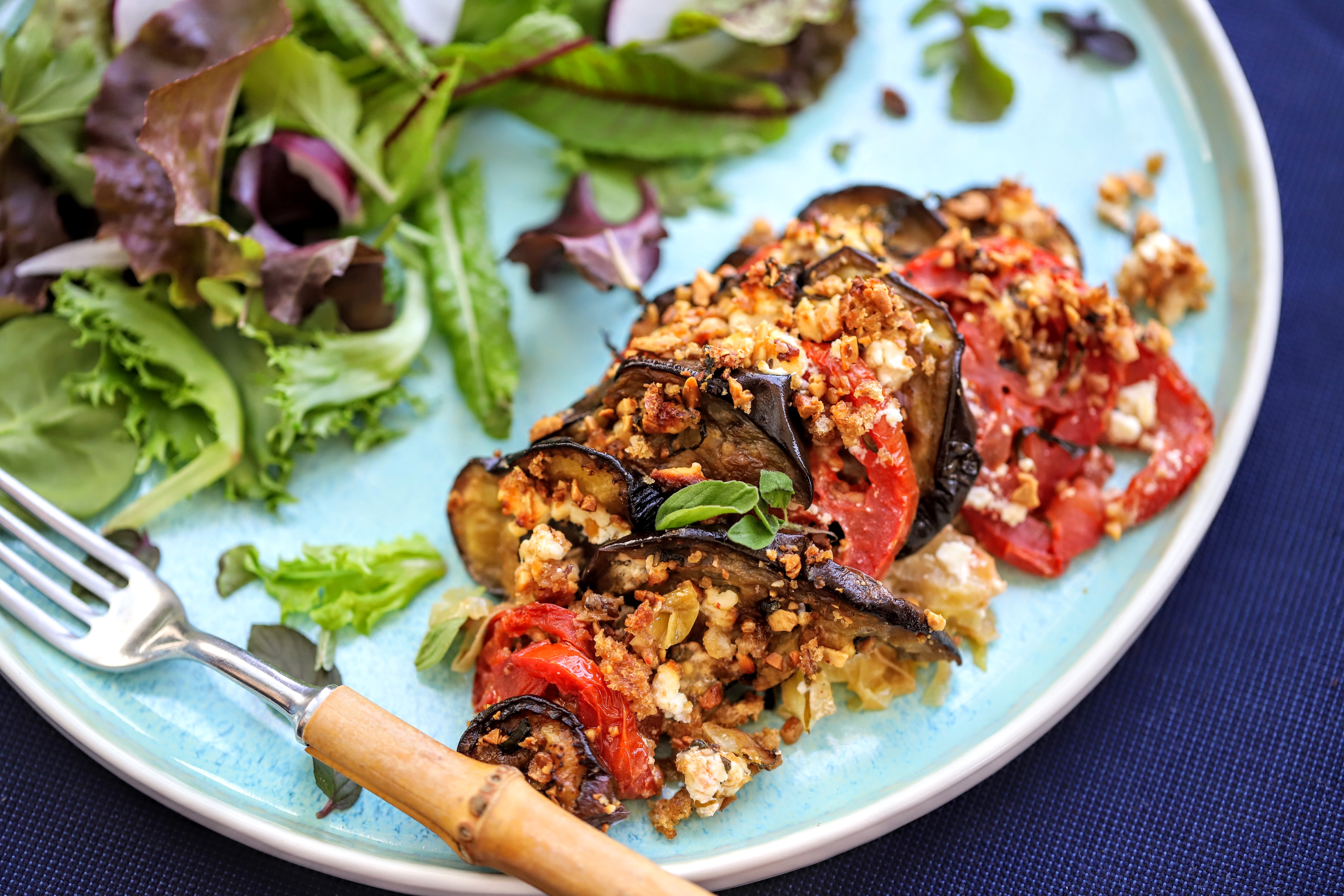Many people do not like eggplant. I’m just going to throw that out there, having gathered data from a highly scientific survey. (I asked my friends.) Then again, some folks couldn’t get enough eggplant after Yotam Ottolenghi made it the poster-veg for plant-based eating when he put it on the cover of his cookbook Plenty: Vibrant Vegetable Recipes from London’s Ottolenghi (Chronicle Books, 2011), and subsequently suggested forty-nine other things to do with it in future cookbooks.
Now I’m no Ottolenghi, but I have included many ways to cook eggplant – grilling, sautéing, roasting, stir-frying – over the years, and though I have heard from cooks all over that a particular recipe for this or that vegetable has changed dinner forever at their house, I confess there’s been very little in the way of eggplant fan mail.
Except in the case of this one recipe. It’s the one that will change your mind if you’re in the “nay” camp.
It’s what the French would call a tian, which is both a dish and a dish. Seriously, it is both the name of a French earthenware casserole and the name of the type of recipe usually cooked in the casserole: a simple arrangement of seasonal vegetables (always including tomato) roasted with herbs and olive oil and often topped with breadcrumbs and/or cheese. In the broader sense, a tian is a gratin – which, by definition, is always baked in a shallow dish and has a large surface area with some type of topping that will crisp up in the oven. But more specifically, a tian always features Mediterranean vegetables that are thinly sliced and arranged in an overlapping manner in the pan (pretty!) rather than being layered on top of each other. A tian will not have cream added to it; there isn’t a “binder” for a tian or the need for a liquid to help cook the vegetables because the tomatoes and other summer vegetables release liquids that help cook the veggies – and reduce to create an intense flavor.
I first learned about tians in culinary school. We made one, I loved it, and I wanted to make more. Later, I developed one recipe that featured zucchini, another with new potatoes, and a third with eggplant. And while the zucchini one (and subsequent versions I’ve done of it) got all the limelight, the eggplant tian was the secret repository of the biggest flavor. Studded with feta cheese, brightened by fresh mint, layered over a bed of caramelized onions, and topped with a crunchy, nutty breadcrumb mixture, the oven-melded eggplant and tomatoes sported a personality to be reckoned with.
And there was another deep flavor secret in the eggplant recipe; before the whole thing was even assembled and baked, the eggplant slices were pre-roasted. I did this for a couple of reasons: I wanted to be sure the eggplant was cooked through (none of that white undercooked flesh left) before being layered with the tomatoes. And I wanted the caramelized flavor that the browned slices would add to the mix. (Plus, these roasted eggplant slices make great snacks all on their own, so there’s that. I always make extra.)
Over the years I’ve grown a lot of eggplant in my Vineyard gardens. As a result, my eggplant tian has gotten a workout and a few tweaks. It’s been at the center of the plate, and it’s been served on the side – next to a grilled steak, a lamb chop, or roasted cod. It’s been heaped on plates at potlucks and parties and eaten as leftovers at home for Sunday supper.
To me, it’s the essence of high summer. And not only can you throw all of your surplus summer eggplant at it, but it will also feed a pack of those crazy-hungry post-vaccination house guests. (Where did they come from?) And I promise they will like it too. In the case of this conversion, I’ve seen it with my own two eyes, many times.
The variation I’m offering you here is my favorite. It begins with a layer of sautéed leeks and includes toasted almonds in the topping. It has a generous hit of mint that perfumes the gratin in a wonderful way, though you could sub in another herb if you prefer. But don’t even think about swapping out the feta – that’s nonnegotiable. (As are the eggplant and tomatoes, of course!) The gratin is good slightly warm or at room temperature, and even more delicious eaten as leftovers the next day.
Come to think of it, I think you should make it for yourself, not the house guests, so that you’ll have leftovers. The house guests can go get takeout!








